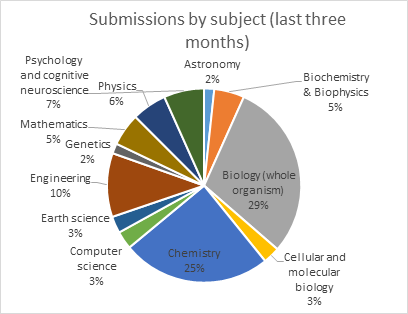 Publishing in parallel. What does it mean and how is it relevant to the theme of Peer Review Week 2017? Well, the Royal Society (RS) journal Royal Society Open Science has been collaborating with the Royal Society of Chemistry (RSC) to jointly peer review and publish chemistry content since 2015. This ‘publishing in parallel’ model, with two societies working to publish one journal, is unique in scientific publishing.
Publishing in parallel. What does it mean and how is it relevant to the theme of Peer Review Week 2017? Well, the Royal Society (RS) journal Royal Society Open Science has been collaborating with the Royal Society of Chemistry (RSC) to jointly peer review and publish chemistry content since 2015. This ‘publishing in parallel’ model, with two societies working to publish one journal, is unique in scientific publishing.
Here, we collaborate again, to explain how the arrangement came about, how it works, and why we think it contributes to the transparency of science.
How does the collaboration work?
In short, the peer review and final editorial decisions of all chemistry papers submitted to Royal Society Open Science are managed by a team of chemistry editors and in-house staff at the Royal Society of Chemistry. Published papers appear with both journal and Royal Society of Chemistry branding in our collection of chemistry papers.
How is the collaboration unique?
This is the first collaboration between two societies publishing in one journal. Royal Society Open Science receives direct submissions, as well as transferred manuscripts from several Royal Society of Chemistry journals (RSC Advances, Chemical Science, Chemical Communications). It’s an exciting venture helping both societies build strategic links, while ensuring they retain a larger fraction of the high-quality content submitted to their journals. Royal Society Open Science gains from the expertise and insight of the editors, while the Royal Society of Chemistry is able to raise its already considerable profile in more multidisciplinary fields of research.
How did the collaboration come about?
One of the goals of the Royal Society of Chemistry was to facilitate networks to support community needs. In discussion with the Royal Society, both parties agreed collaboration would be a great way to achieve these aims. By handling the chemistry section, the Royal Society of Chemistry was able to offer its authors the option to publish open access in compliance with their funding requirements; the option of objective peer review with no restrictions on scope, article length or impact; the possibility of open peer review and open data publication, as well as more widespread visibility in an interdisciplinary scientific journal – all unique features the Royal Society of Chemistry was unable to offer its authors at the time.
How does the collaboration contribute to transparency in peer review?
Uniquely, the collaboration provides both societies an opportunity to see how another publisher works, and to openly discuss respective experiences regarding peer review and journals, which is not a given in the publishing landscape. This is of great benefit to both societies and can only improve services for authors and readers.
In particular, the collaboration provides authors with the chance to observe and compare the benefits (and challenges) of closed versus open peer review. While it is not mandated, Royal Society Open Science encourages open peer review for all authors and referees, including those submitting chemistry papers. Over the last year, almost three quarter of authors and well over half of reviewers have taken advantage of this option.
When both parties agree to open peer review, we publish the decision letters and reviewer correspondence alongside the final article. We hope eventually to be able to assign reports a DOI to allow them to be effectively cited, and to help researchers build their portfolio of outputs. The advantages of open peer review include improving the transparency of the published paper’s journey from submission to acceptance; it provides a mechanism for referees to self-identify and to gain recognition for their hard work (as does the journal’s integration with Publons); and helps
reviewers to compare and write better reports.
Finally, Royal Society Open Science has introduced Registered Reports, which will make research more transparent and help to fine-tune study design, as well as minimising some forms of publication bias. The Royal Society of Chemistry has been instrumental in raising awareness of these article types more widely among the chemistry community.
How has the collaboration been received by the chemistry community?
Both societies have been pleasantly surprised by the support and feedback the collaboration has received. Authors involved have been almost universally positive. The societies have benefited in a number of ways. Royal Society Open Science struggled to attract high-quality and diverse chemistry submissions before the collaboration. Now, a fifth of all manuscripts are submitted to the chemistry section. The transfer of scientifically sound research papers from the Royal Society of Chemistry to Royal Society Open Science is important in in giving all authors a platform to publish their work, especially if it helps people avoid repeating negative results, which previously have mostly ended up hidden away in lab books.
Our Chemistry Subject Editor, Professor Anthony Stace FRS, has also echoed the successes of the collaboration:
“As the subject editor with responsibility for chemistry submissions to Royal Society Open Science, I have found the experience of working with both the RS and the RSC to be very rewarding. As already noted, some Royal Society journals have in the past found it difficult to attract high-quality chemistry papers, but through this collaboration and the ability of the RSC to attract work of the highest standard, we have seen a significant reversal of that situation. Hopefully, some of this success will spill over into other Royal Society journals.”
What challenges does the collaboration face and how have you overcome them?
The chemistry community’s initial lack of familiarity with Royal Society Open Science was a challenge. However this has been addressed by ramping up joint marketing efforts; with the Royal Society of Chemistry providing details about the collaboration to chemistry researchers, and expanding the number of journals offering transfers, ensuring much greater visibility for Royal Society Open Science. As can be seen in the corresponding graph, a quarter of submissions received by the journal are now from the chemical sciences.
A future challenge will be the introduction of article processing charges by the journal. Authors will be supported during the transition to charging and APC by discounts and waivers for resource-limited authors, ad hoc waivers for invited pieces and the Royal Society of Chemistry’s own experience of the transition of RSC Advances; they will be helpful in supporting the process and ensuring it runs as smoothly as possible.
What’s next for the collaboration?
More of the same! As well as increasing the number of published papers, the editors are exploring opportunities to commission high-quality reviews and special collections, to raise the profile of researchers in emerging fields. We will also be launching an Advisory Board comprising internationally renowned experts, who will assist the editors in providing ad hoc advice. The first 18 months of the collaboration have laid great foundations for further success – watch this space!
View our collection of Chemistry articles or contact us for questions regarding Royal Society Open Science.
Andrew Dunn – Senior Publishing Editor, Royal Society
Alice Power – Editorial Coordinator, Royal Society
Michaela Muehlberg – Deputy Editor, Royal Society of Chemistry











